Dodge A100 Forward Control Van: Fitting a custom Radiator #4
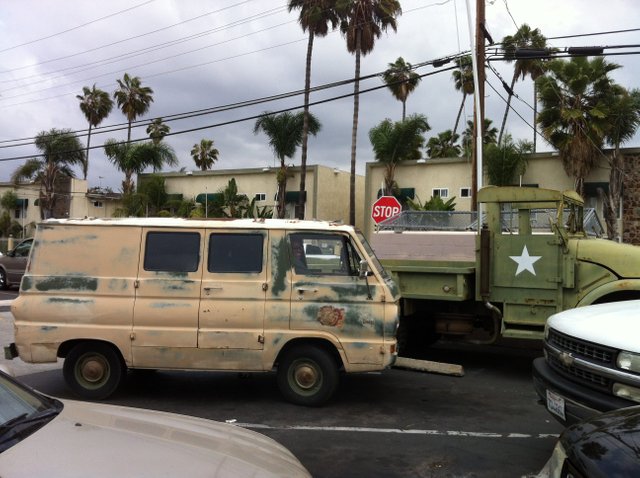
Well here I am again, clogging up the ether with another edition of This old Hoopty. Today I did cleanup of the van so I could work on the entire doghouse. Vans tend to collect stuff, and mine is no exception.
Here is the folding back seat, plus the front passenger seat, and assorted crap.
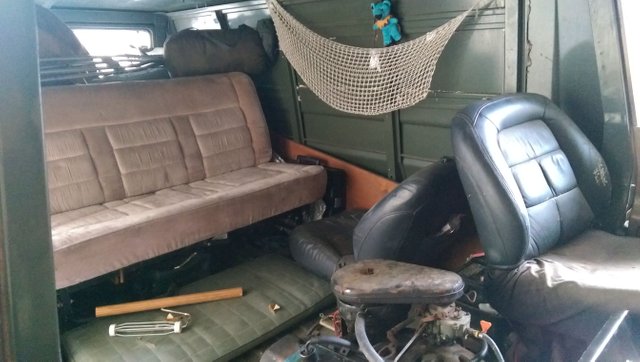
Looking forward
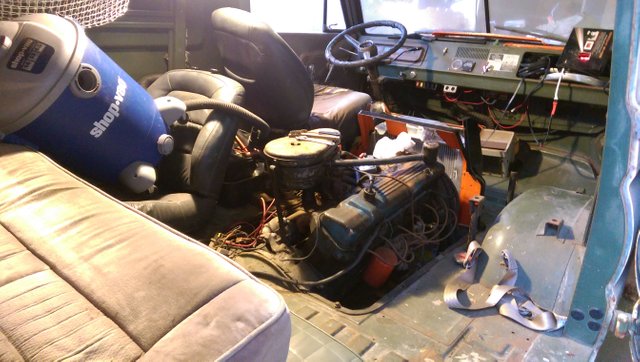
Looking back at the inside from the front window. Back seat is all the way forward. When folded down, it reaches within 6" of the doghouse.
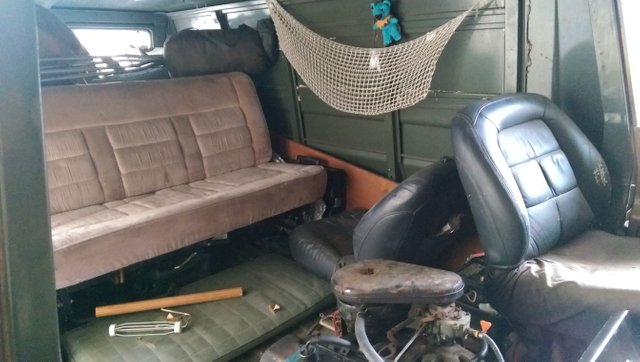
Battery is in sad shape, so I set up my solar powered charging system (Box on dash)
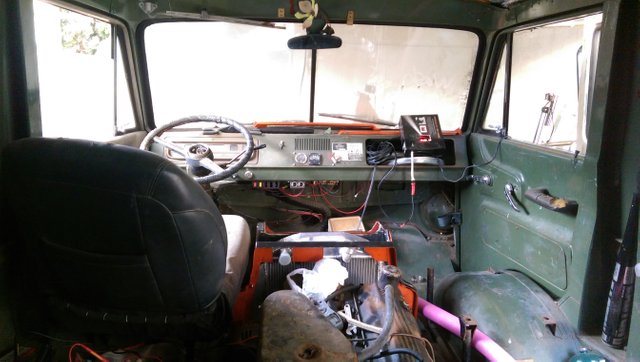
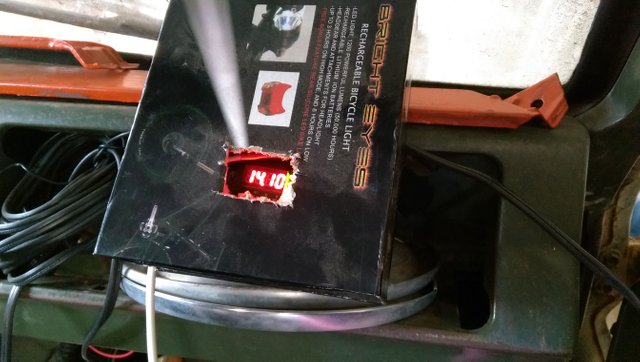
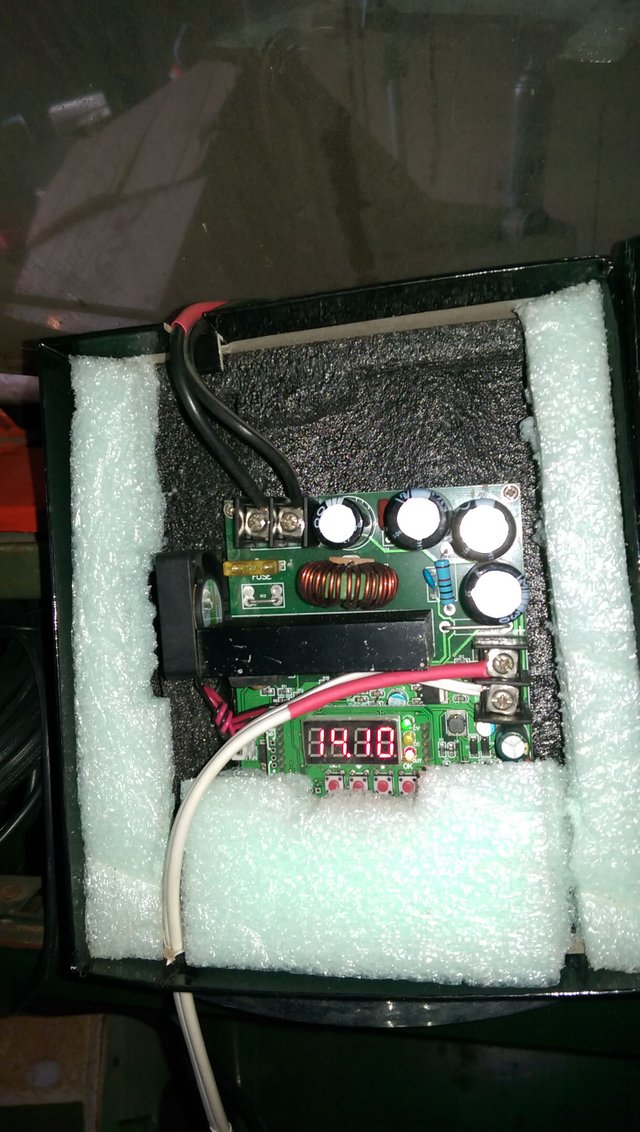
This 64 Dodge A100 runs the LG 170 Slant-6 powerplant.
The engine has a bore of 3.40 in (86.4 mm) and a stroke of 3.125 in (79.4 mm) for an actual displacement of 170.2 cu in (2.8 L). Connecting rod length is 5.669 in (144.0 mm). The "LG" low-deck block was unique to the 170 engine.his produced 101 horsepower and 155 Ft/lbs torque
The Chrysler Slant-6 engine was a clean-sheet design, led by Willem Weertman. Its characteristic 30° inclination of cylinder block gives it a lower height overall engine package. This enabled vehicle stylists to lower hoodlines, and also made room for the water pump to be mounted with a lateral offset, significantly shortening the engine's overall length. The slanted cylinder block also provides space in the vehicle's engine bay for intake and exhaust manifolds with runners of longer and more nearly equal length compared to the rake- or log-style manifolds typical of other inline engines. The Slant-6 manifold configuration gives relatively even distribution of fuel mixture to all cylinders, and presents less flow restriction. This, in turn, provides for relatively good airflow through the engine despite the intake and exhaust ports being on the same side of the head rather than in a cross-flow arrangement.
It was introduced in two piston displacement sizes in 1960: The 170-cubic-inch (2.8-litre) "LG" (Low-G, referring to the relatively short engine block casting and crankshaft stroke) in the Valiant, and the 225-cubic-inch (3.7-litre) "RG" (Raised-G, referring to the relatively tall engine block casting and crankshaft stroke) in full-size Plymouth and Dodge Dart models. In 1960, the engine was called the "30-D Economy Six" engine by Plymouth marketers, referring to the 30° cylinder block angle.
The G-engine was offered in various configurations in the North American market until 1983 in cars, 1987 in trucks, and 1991 for marine, agricultural, and industrial use. Replacement engines were built in Mexico through 2000. The G-engine was used by Chrysler's international operations in locally produced vehicles. It was also purchased by other original equipment manufacturers for installation in commercial vehicles, agricultural and industrial equipment, and boats.

Last up, final coat on the deck lid. Tomorrow, after work, I will start insulating the panels, and will mount the back panel for sure. I still have some captive nuts to replace in the floor as well, befor I can do a final doghouse install
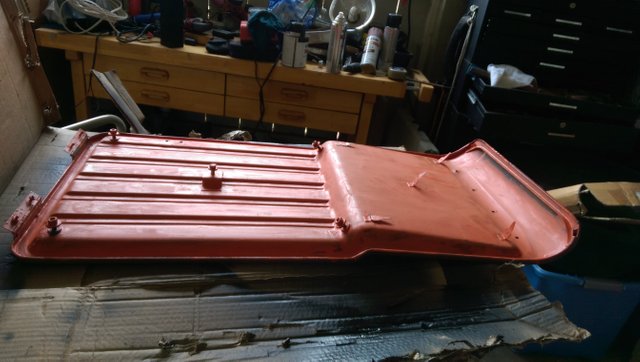
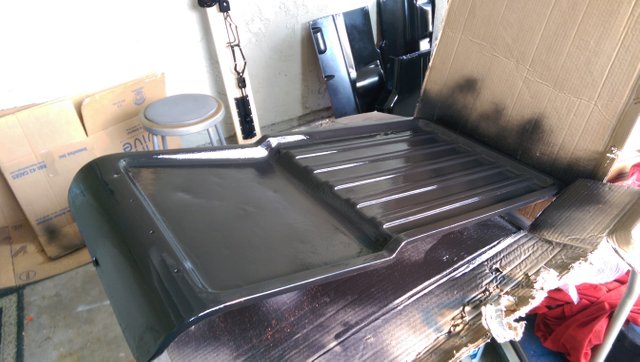
This nearly completes a 3 year odyssey to get a radiator in this van, ands I will be very happy some time next week, when I take it for a drive.I just need to button up the bottom of the engine bay, get a top radiator hose, fill it, and put in fuel. Assuming the battery will crank it, It's really just a couple days away.
For Previous updates, look below
Update 1
Update 2
All imagery by @dawg-boy
If you enjoy my original content, please upvote, resteem, and follow me@dawg-boy
#socalsteemit is building and supporting the Steemit community of Southern California. If you are from SoCal and are into creating quality content here on Steemit, we'd love for you to follow us @SoCalSteemitand join our group on Discord
Nice work and thanks for the engine information i like that.
What can I say... It is a great design for a high torque application. Not a speed demon, although the Aussie versions were turned into some hot cars. The fact that Chryseler went with a forged Crankshaft, forged rods, forged pistons, and a high Nickel Iron content block and head means that even after 53 years, this beast still purrs.
First time I fired it up after installing a new wiring harness:
Ahh, music! Congratulations 😁
The engine was fully rebuilt with new bearings, rings and valves in 2001.. It maybe has 5000 miles on that rebuild. As you can see from the mess, I completely rewired it, changed out the fuel lines and hoses, the tank sending unit, fuel pump/waterpump. thermo, and all hoses before this firing... And afterwards, a new old stock carburetor, and a bunch of messing around with the cooling system. The pusher fan was an addition that has a manual switch. I think I may not need it any more, but hey, it never really hurts to have more cooling, right?
Hoping my insulation does the sound and heat trick... And the old radiator may get turned into a Ghetto AC unit...
Yes, the more cooling the better, especially after you bolt on the turbo. By the way, what's an AC unit. jk
How did you know the engine was rebuilt with only 5000 in it afterwards. Stories like that make me wonder why and then what happened after it was rebuilt?
So I am the 3rd owner. Second owner was the California Institute of Technology, Palomar Mountain Observatory, where it was the painter's van for 28 years, and never left the 4400 acre compound. They rebuilt the tranny and engine in winter 2000/2001, and then drove it for 4 years , with the longest single leg being about a half a mile... in 2005, the wiring harness melted together, and they towed it off the road and parked it until I started working there in 2009, and managed to snag it before they sold it to a scrapper... I got it running by "Mickey Mousing" a wiring solution, and verified the engine ran fine, and then parked it until 2012-13 when I started the wiring harness project... Going to post about that project soon... Compression was 185 PSI across all 6 cylinders. My next real project as far as the engine goes is to find a 2 barrel manifold(Likely out of Australia) adding a Throttle Body Fuel injection system, and MS electronic ignition.
Good story. You saved it. Unique history on that thing.
Some of the melty carnage under the dash(This is looking straight up from the floor)... Those two big wires with the copper showing are the hot line from the alternator, to the dash mounted ammeter, and then back to the battery... They were arc-welded together for more than 6 feet, and all the other wiring was melted into it. only reason this thing was not a fireball was because steel is hard to burn...
Beuty mate.
Yeah, I was very curious about that engine. I'm really glad for your lesson about the 30° D
World of Photography Beta V1.0
>Learn more here<
You have earned 5.50 XP for sharing your photo!
Daily photos: 1/2
Daily comments: 0/5
Multiplier: 1.10
Server time: 06:02:08
Total XP: 71.45/100.00
Total Photos: 13
Total comments: 3
Total contest wins: 0
Follow: @photocontests
Join the Discord channel: click!
Play and win SBD: @fairlotto
Daily Steem Statistics: @dailysteemreport
Learn how to program Steem-Python applications: @steempytutorials
Developed and sponsored by: @juliank
The Vote For Your Awesome Post Has Just Arrived!
NOVOTES.SteemiTag is an innovative program that helps users increase their gains in the curation rewards by voting on posts that are likely to get high payouts. It maximizes the chance of a user to be rewarded through an accurate selection algorithm that works 24/7 and eliminates "no rewards" problem for users with low Steem Power. You can participate in our program by clicking on this link and confirming your delegation. Your rewards will be sent to you in the form of weekly dividends. Thank you and keep up with your great work!
Wow @dawg-boy. I didn't realize you knew so much about old engines. Pretty cool stuff. I usually go Japanese for durability and easy maintenance, though we did get a Fusion. It's been a decent 4 cylinder.
I drive a Toyota Camry... I get you, but an old classic like this is great to have. Since the drive train is so ubiquitous across the Mopar lines, parts are cheap too, other than that platinum coated radiator. I won't own American later than '75... I love this old slant 6 too, it's torquey, and gets 21 mpg. I need to re-gear the axle as it's not real speedy on the freeway.
21 isn't bad with some get up and go. I never complain about having to drive around an old VW Bus. It's admiration instead.
I do miss my Camry 6 cyl. Such a dependable vehicle and it would fly when I needed it to. :)
Went for a new Sentra SV. It's okay....a little too small though.